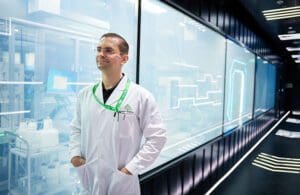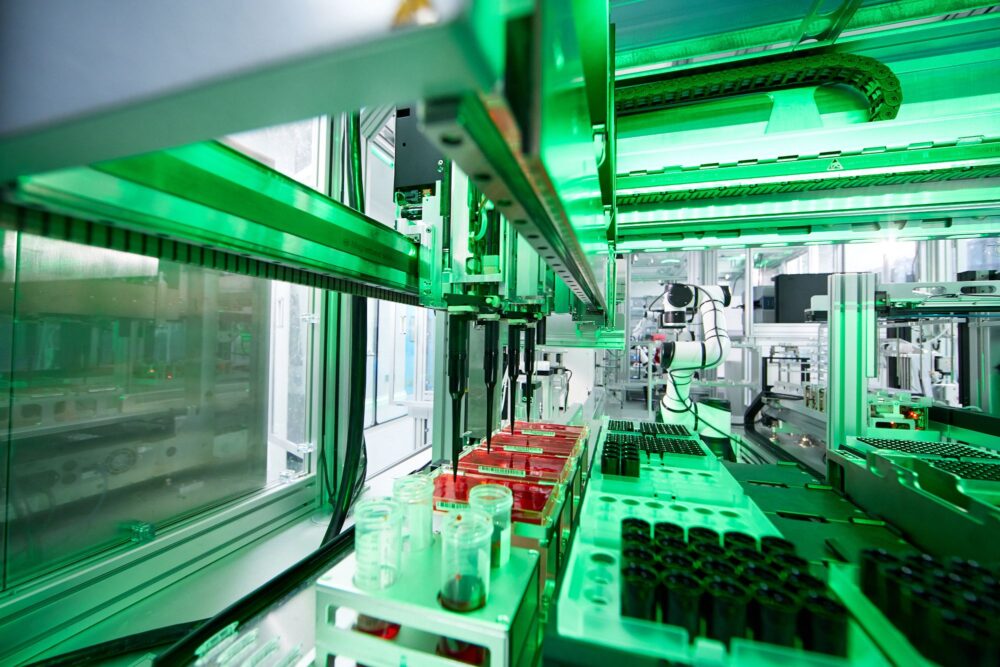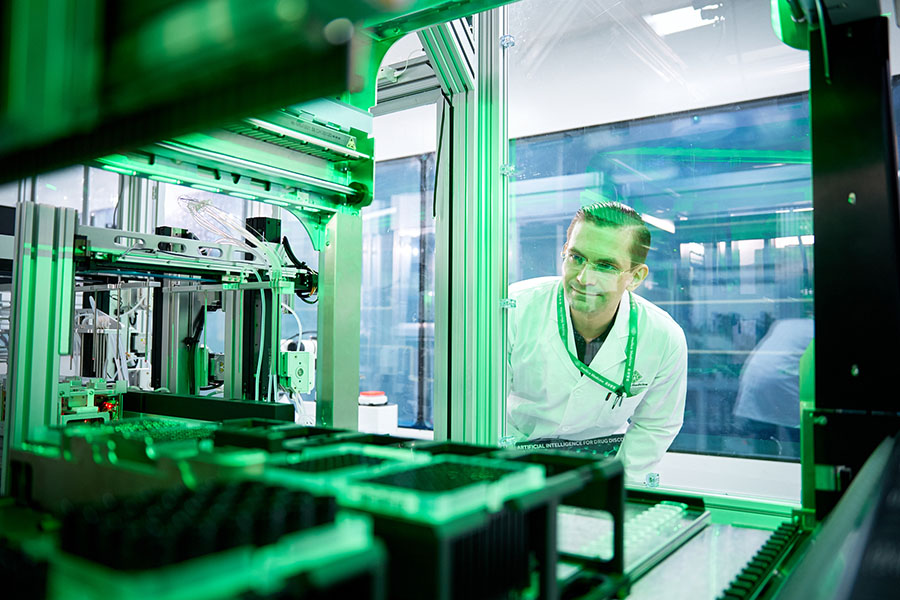
This is the AI-powered autonomous robotics lab called Life Star in Suzhou that Insilico opened in January. [Insilico Medicine]
The AI drug discovery project consisted of Insilico Medicine, the University of Toronto’s Acceleration Consortium and researchers including Nobel laureate Michael Levitt. The team applied AlphaFold to Insilico’s end-to-end AI-powered drug discovery platform, Pharma.AI. With the integration of the biocomputational engine PandaOmics and the generative chemistry engine Chemistry42, the AI drug discovery project identified a novel treatment pathway for HCC and developed a potent inhibitor based on a predicted protein structure.
In the following interview, Alex Zhavoronkov, founder and CEO of Insilico Medicine, shares insights into the process and implications of this rapid drug development. He also touches on the role of AI in identifying potential treatments and overcoming challenges in drug discovery and development.
Can you explain how the AI drug discovery project between Insilico Medicine and the University of Toronto’s Acceleration Consortium led to the discovery of a potential drug in only 30 days?

Alex Zhavoronkov
Zhavoronkov: We wanted to show that AlphaFold protein database has some practical utility for drug discovery and partnered with our dear friend and advisor, Alán Aspuru-Guzik. We decided to go after hepatocellular carcinoma (HCC) as there are few great targets. We used our commercially-available platform PandaOmics, which utilizes multiple target prediction engines including transformers and other generative AI approaches to identify promising targets for HCC. CDK20 was on the list and it did not have a crystal.
There are limited CDK20 inhibitors reported despite great success being achieved with inhibitors against other members of the CDK family. One possible reason is that there is no available 3-D structure for this target. Combining the AlphaFold predicted protein structural re for CDK20 with our generative AI drug design platform, Chemistry42, our platform suggested binding sites for a small molecule inhibitor of CDK20. Ultimately, we wanted this research to demonstrate that it is possible to use a predicted structure for a novel target and come up with usable chemical data. We not only accomplished that goal, but we did it in less than 30 days.
How does AI’s ability to sort through vast amounts of information and identify multiple potential drug targets contribute to the development of more effective treatments?
Zhavoronkov: AlphaFold is a computer program from Alphabet’s DeepMind that has predicted the protein structure of every known protein using AI. This free AI-powered database can predict the 3D structures of millions of proteins from their primary amino acid sequences with an accuracy that rivals experimental methods. AlphaFold – and now AlphaFold2 – is considered a major breakthrough in AI and structure-based biology which can help accelerate the development of new medicines. When we first learned of this breakthrough, we were eager to apply it to our own AI platform to see if we could further accelerate our target discovery and novel drug design, particularly for a target without a known experimental structure.

AI-powered autonomous robotics lab called Life Star in Suzhou that we opened in January
What role did the AI-powered drug discovery pipeline play in identifying the weak spot in the liver cancer protein and designing a molecule to target it?
Zhavoronkov: First, PandaOmics, our AI target discovery engine, identified the protein of interest, CDK20, due to its strong disease association, limited experimental structure information, and shortage of approved drugs or clinical compounds in the context of any disease during the last 3 years. PandaOmics is a generative AI software engine designed for therapeutic target and biomarker discovery that includes more than 20 AI and bioinformatics models. It uses in silico pathway activation network decomposition analysis and generative AI approaches to identify novel targets and biomarkers. We then utilized a predicted protein structure from AlphaFold2 and applied this predicted structure to our Chemistry42 generative AI drug design engine which integrates generative AI algorithms with computational and medicinal chemistry methods to generate novel molecules with drug-like properties, utilizing over 40 generative models, including generative autoencoders and generative adversarial networks.
It took us only 30 days to discover our first hit. The predicted binding mode was then used as guidance for the second-round compound generation, synthesis, and testing, which resulted in a more potent hit molecule ISM042-2-048 with nanomolar potency. To the best of our knowledge, this work is the first reported example that successfully utilized AlphaFold-predicted protein structures to identify a confirmed hit for a novel target in early drug discovery.

AI-powered autonomous robotics lab called Life Star in Suzhou that performs target discovery, compound screening, precision medicine development and translational research. [Insilico Medicine]
What are the future implications of this AI drug discovery project, as demonstrated by this proof of concept?
Zhavoronkov: Technology is rapidly evolving, and with our AI platform, we are able to incorporate these latest advances as they become available and integrate them into our processes to improve speed and efficiency. Utilizing AlphaFold2 for dark targets that lack experimentally determined structures is one example.
We also added a fully autonomous AI-powered robotics lab called Life Star to our operations in January, which performs target discovery, compound screening, precision medicine development, and translational research, allowing us to further accelerate the testing and validation of AI-generated molecules.
And just last month, we were the first biotech company to incorporate chat functionality into our platform, building on recent advances in large language models. We call this tool ChatPandaGPT, and it is part of the knowledge graph functionality of our target discovery engine, PandaOmics. ChatPandaGPT draws from a specialized knowledge base and can help researchers quickly and efficiently find answers related to a particular disease, relevant studies and findings, related biological processes and targets of interest. We’re looking at ways to incorporate this into other parts of our platform.
How does AI’s ability to sort through vast amounts of information and identify multiple potential drug targets contribute to the development of more effective treatments?

Another view of Insilico Medicine’s AI-powered autonomous robotics facility. [Image courtesy of the company]
Our end-to-end platform also includes clinical trial outcomes predictions, the stage at which most drugs in development fail. The AI models underlying InClinico allow researchers to better understand the probability of the success of clinical programs during the critical transition from phase II to phase III.
At every stage of the process — target discovery, drug design, and clinical trial prediction— AI finds patterns in multimodal data that are beyond the capability of human researchers.
What are your thoughts on the challenges that still need to be overcome in order for AI-discovered drugs to become widely used in drug discovery and development?
Zhavoronkov: While there is still skepticism in the industry, AI is being explored by most big pharma companies looking to advance their own programs and accelerate the pace of drug discovery. There is still no AI-generated small molecule drug treating patients, which many are waiting for. (You can find a good roundup of biotechs in the race to get AI-designed drugs to patients in this story in Inside Precision Medicine.
I should note that Insilico Medicine is the first company with an AI-discovered and AI-designed drug from generative AI that went through many steps of experimental validation and is now nearing Phase 2 trials in human patients, which is very exciting for us and for the industry. This lead drug candidate, for the devastating lung condition idiopathic pulmonary fibrosis, recently received positive topline Phase 1 results and Orphan Drug Designation from the FDA. We also have the first generative AI-produced drug for COVID-19 and related variants in clinical trials.
Insilico Medicine has many other drugs advancing in our pipeline that are available for licensing — including many in the cancer space. The company is showcasing four of these novel cancer inhibitors at the upcoming AACR meeting in Orlando. And we just published another potent novel cancer inhibitor in the Journal of Medicinal Chemistry.
Following this AI drug discovery project, Insilico Medicine is not planning to pursue clinical trials for the discovered drug. What are the reasons behind this decision?
Zhavoronkov: We are not pursuing the development of this particular drug into clinical trials, although the molecule is now publicly available for other researchers to pursue. The purpose of the study was to serve as a proof of concept of what is now possible with AI – demonstrating that it is possible to use a predicted structure for a novel target and usable chemical data in just 30 days.
Filed Under: Drug Discovery, Drug Discovery and Development, machine learning and AI



